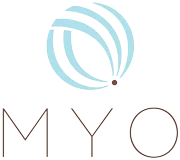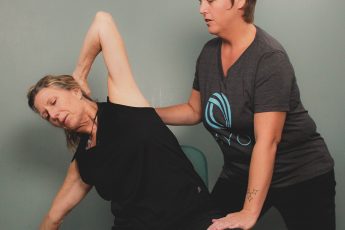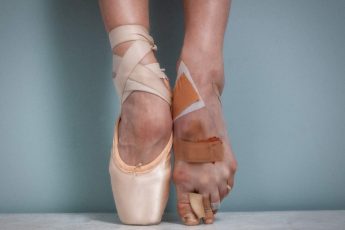You already know how to move… right? To the extent of our abilities, we all do it every day. But when you think about it, you probably don’t move as well now as you did as a child. As infants, we rock, roll, and crawl. We progress to running, climbing, jumping, dancing and playing for hours every day. And then? Gradually, we are trained to move less. Sit still. Stop fidgeting. Focus. Listen. Be good. Movement becomes something you do only at recess and gym class. Some of us go on to train in a particular sport or physical activity, but only in certain ways, at certain times and seasons. As adults, movement happens in limited, repetitive patterns. It’s rare that we have the variety, frequency, or freedom of movement that we had as children. That, more than aging itself, is what leads to the reduced capabilities most people experience as they age. We stiffen into the patterns that we use most often.
In a sense, Movement Foundations classes are a fountain of youth. They bring us back to the developmental, non specialized skills and strength we need in order to be really versatile and free in our movement, like we were as children.
Despite what many fitness gurus and brands will try to tell you, there’s nothing new about fitness systems that focus on quality and diversity of movement rather than specialized performance. But despite a recent resurgence of ‘caveman’ fitness as part of the overall paleo trend, natural movement systems are still the underdog in the fitness world. Even Crossfit, which shares some of the same origins and focus on functional strength, is heavily weighted toward performance and competition rather than quality of movement.
Although we can trace the roots back as far as ancient Greece, modern fitness and training techniques largely stem from systems developed in the 1800s in the wake of the industrial revolution. At the time, there was growing concern about the ‘diseases of affluence’ brought about by an increasingly sedentary workforce. Competing systems of fitness and strength training (and gymnasiums to practice in) popped up all over Europe, introducing equipment like parallel bars, pommel horses, and stall bars, and formalizing systems of calisthenics and stretching.
One of the thinkers to emerge from this trend was Georges Hébert, a physical instructor for the French Marines in the early 1900s. He believed that the dominant fitness systems coming out of Sweden and Germany led to uneven muscular development and inadequate preparation for the practical demands of life, and that organized sports focused too heavily on competition and performance. Instead, he believed that exercise should result in practical ability, moral purpose, and courage. His philosophy was strongly influenced by his experience during his Navy service of a volcanic eruption, during which he coordinated the rescue of around 700 people. This was the basis for his personal motto, “Être fort pour être utile” (“Be strong to be useful”).
In developing his training system, called the Natural Method, Hébert built on the existing exercise systems of his time and incorporated concepts of progressive training (ie the idea that training should start at an accessible level for each individual so as not to exclude less skilled individuals, and develop from there), as well as influences of the popular ‘back to nature’ movement, including his observations of habitual physical activities among indigenous people around the world. The system focused on developing practical skills like climbing, swimming, fighting, balancing, and crawling, while also challenging the fears associated with falling or jumping, to develop strength in both body and character. If possible, these exercises were to be performed in nature to maximize spontaneity and preparedness for unpredictable environments.
Hébert’s ideas eventually formed the basis of all French military training, and in particular, the use of the “parcours” or obstacle course. More recently, his teachings have been heavily influential in the development of Parkour as a sport in its own right. The Natural Method is also the primary source for the MovNat® system developed by Erwan LeCorre, as well as many other Primal or Paleo inspired fitness trends.
Just as they were a century ago, fitness practices that emphasize muscle isolation, competition and performance are dominant over natural movement systems today. But the natural movement philosophy persists in many lesser known systems. Each is slightly different in focus, language and exercises, but they share overlapping elements and goals. They work with developmental and restorative movement to reset the nervous system, wake up neglected muscles, and restore fundamental strength, mobility and coordination. Then they work on developing strength, flexibility and control in all possible planes of movement, from rolling on the ground, to squatting, to hanging from a branch. With practice, the end result is a conditioned, graceful and infinitely more capable body.
To us, this way of looking at fitness makes so much sense. It represents a paradigm shift from unbalanced, piecemeal training that so often causes injury, to integrated, practical training that prevents injury and provides a solid foundation for everything else. In Movement Foundations classes at Myo, you will experience elements of the Natural Method described above, along with other related systems. We also offer Original Strength®, a movement restoration system that uses developmental movement patterns like crawling, rocking, and rolling, to reset the vestibular system, integrate and coordinate the body’s movement and posture, and ultimately restore posture, strength, balance and flexibility. All of our classes are progressive – meaning that you can join at any level and add intensity over time.
Kevyn McAnlis, who teaches Movement Foundations at Myo, got her start as an athlete and yoga teacher. After repeated injuries from Vinyasa style yoga, she began to explore corrective movement through Yoga Tune Up®, which works to improve posture and reduce pain through a blend of yoga, corrective exercises, breath work and self-massage. She is also Level 1 MovNat certified, and a practitioner of Z-Health, a fitness system that seeks to reshape the way you train by focusing on and improving the connection between the brain and body. By incorporating brain based activities, natural movement and weight based practices she helps people find the right balance of work and play in their movement sessions.
Kirby Sams, who teaches Original Strength, is a life-long mover and athlete, and a trainer since 1991. He was injured and partially paralyzed playing football in college. Although he didn’t realize it at the time, he used the guidelines of OS, diaphragmatic breathing, vestibular motions and cross midline movement crawling, to restore his body to the way it was meant to be. He is a Certified Strength and Conditioning Specialist, SFG1 Kettlebell Certified, TRX Suspension Training Certified, Functional Movement Systems Level 1 Certified, and of course, an Original Strength Certified Pro. He works with all populations, however he particularly enjoys changing the lives of people over the age of fifty.
You can learn more and sign up for all our classes here. For more information on Georges Hébert, the Natural Method, and the fascinating history of fitness and physical education, check out the links below.
https://www.movnat.com/the-roots-of-methode-naturelle/
https://www.artofmanliness.com/articles/the-history-of-physical-fitness/
https://en.wikipedia.org/wiki/Georges_H%C3%A9bert
https://en.wikipedia.org/wiki/Physical_culture
https://en.wikipedia.org/wiki/Parkour
https://stuff.maxolson.com/Practical-Guide-of-Physical-Education-1912.pdf



